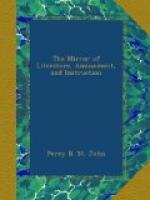SYLVESTER.
* * * * *
EXCELLENCE.
Of all chaste birds the phoenix doth excel,
Of all strong beasts the lion bears the
bell,
Of all sweet flowers the rose doth sweetest
smell.
Of all pure metals gold is only purest,
Of all the trees the pine hath highest
crest.
Of all proud birds the eagle pleaseth
Jove,
Of pretty fowls kind Venus likes the dove,
Of trees Minerva doth the olive move.
LODGE.
* * * * *
THE NATURALIST.
COCHINEAL INSECT AND PLANT.
[Illustration: COCHINEAL INSECT AND PLANT.]
The frequent mention of the Cochineal Insect and Plant in our pages will, probably, render the annexed cut of more than ordinary interest to our readers.[3]
[3] See the Propagation of
the Insect in Spain, MIRROR, vol. xii.
and
an attempt to naturalize the same at the Cambridge
Botanical
Garden,
page 217, of the present volume.
The plant on which the Cochineal Insect is found, is called the Nopal, a species of Opuntia, or Prickly Pear, which abounds on all the coasts of the Mediterranean; and is thus described by Mr. Thompson, in his work entitled, Official Visit to Guatemala; “The nopal is a plant consisting of little stems, but expanding itself into wide, thick leaves, more or less prickly according to its different kind: one or two of these leaves being set as one plant, at the distance of two or three feet square from each other, are inoculated with the cochineal, which, I scarcely need say, is an insect; it is the same as if you would take the blight off an apple or other common tree, and rub a small portion of it on another tree free from the contagion, when the consequence would be, that the tree so inoculated would become covered with the blight; a small quantity of the insects in question is sufficient for each plant, which in proportion as it increases its leaves, is sure to be covered with this costly parasite. When the plant is perfectly saturated, the cochineal is scraped off with great care. The plants are not very valuable for the first year, but they may be estimated as yielding after the second year, from a dollar and a half profit on each plant.”
The insect is famous for the fine scarlet dye which it communicates to wool and silk. The females yield the best colour, and are in number to the males as three hundred to one. Cochineal was at first supposed to be a grain, which name it retains by way of eminence among dyers, but naturalists soon discovered it to be an insect. Its present importance in dyeing is an excellent illustration of chemistry applied to the arts; for long after its introduction, it gave but a dull kind of crimson, till a chemist named Kuster, who settled at Bow, near London, about the middle of the sixteenth century, discovered the use of the solution of tin, and the means of preparing with it and cochineal, a durable and beautiful scarlet.




